An Immense World: How Animal Senses Reveal the Hidden Realms Around Us
Air Date: Week of November 4, 2022
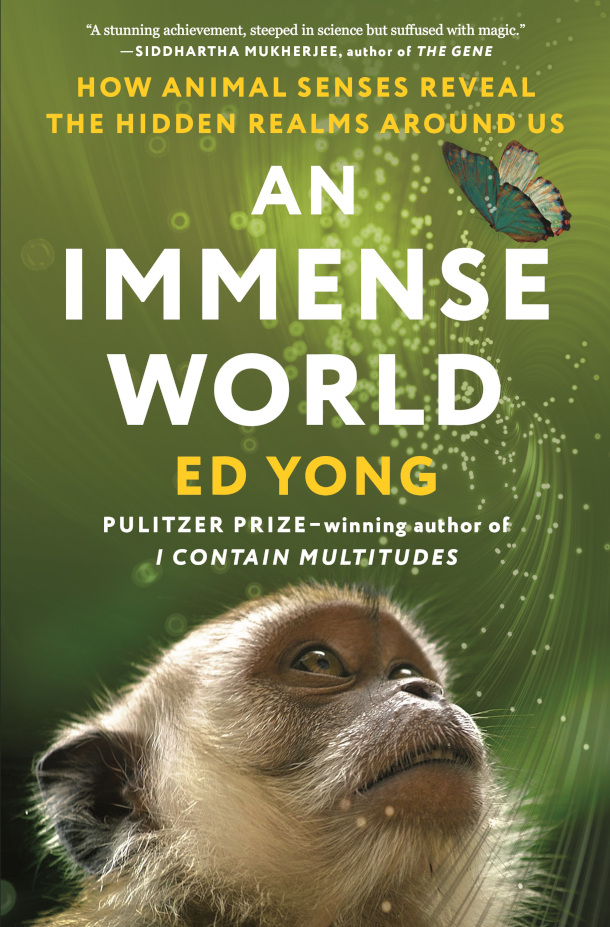
Ed Yong’s 2022 book An Immense World: How Animal Senses Reveal the Hidden Realms Around Us (Photo: Courtesy of Penguin Random House)
Every animal species experiences the world in a way that is totally unique to them. Mantis shrimp, for example, have many more photoreceptors than humans and can filter polarized light, and star-nosed moles can smell under water. At a recent Living on Earth Book Club event, author Ed Yong joined Living on Earth’s Steve Curwood to share the fascinating sensory abilities he learned about in researching his new book, “An Immense World: How Animal Senses Reveal the Hidden Realms Around Us”.
Transcript
BASCOMB: It’s Living on Earth, I’m Bobby Bascomb.
Every animal species experiences the world in a way that is totally unique to them. Mantis shrimp, for example, have many more photoreceptors than humans and can filter polarized light, and the star-nosed mole can smell under water. Since we have none of these abilities, it can be hard to relate to other species. But shifting our understanding can help us respect our fellow creatures and make better decisions when it comes to the world we share. Pulitzer Prize winning author Ed Yong set out to explore world the way animals do in his new book “An Immense World: How Animal Senses Reveal the Hidden Realms Around Us”. Ed joined Living on Earth’s Steve Curwood for a recent LOE book club event.
CURWOOD: Now you've been writing about sensory biology for a decade or more, but think it was 2018 that you decided to do this compendium of what you call 'umwelten', that's a German word. So explain for us, by the way, what's an 'umwelt'?

Ed Yong is the author of An Immense World: How Animal Senses Reveal the Hidden Realms Around Us (Photo: Courtesy of Penguin Random House)
YONG: So the word 'umwelt' is German for 'environment', but in this context, we're not talking about the physical environment. It is the sensory environment. It is specifically the sights and sounds and textures and smells that exist in the world that I can perceive and that might well be unique to me as an individual or certainly as a species. The core thesis of this book is that every creature has its own particular set of sensory information that it can pick up, it is only perceiving a thin sliver of the fullness of reality. And that, I think, is a wonderfully humbling and expansive idea. It is humbling because I feel sitting here right now that my perception of the world is complete. I'm certainly not, you know, grasping for things that I feel like I'm missing. And yet I'm missing so much. I am not perceiving the ultraviolet colors that a bee or a bird might be able to see, I can't feel the magnetic field of the Earth in the way a sea turtle can. I can't hear ultrasonic frequencies that mice or bats can hear. There is much around me that I am completely oblivious to, even if it doesn't feel that way. But that is also, I think, a beautifully expansive idea. It means that even in the most familiar of settings, there is wonder and magic to be found. By thinking about how my dog sniffs his way around the neighborhoods that I walk down thousands of times every year, I see those environments in new ways. By thinking about, you know, what a seabird like an albatross perceives as it flies over a featureless ocean, the ocean doesn't become so featureless anymore. That's why the book is subtitled in the way it is. It's not just about thinking about animals in a new light. It's about what animals can teach us about thinking about our world in a new and more profound way.
CURWOOD: You also give us a taste of how it matters to them, the whole notion of consciousness for these creatures. I don't want to anthropomorphize this, but I have to wonder, am I torturing my dog when I don't let her stop and sniff when I go walking at my local dog-friendly forest?
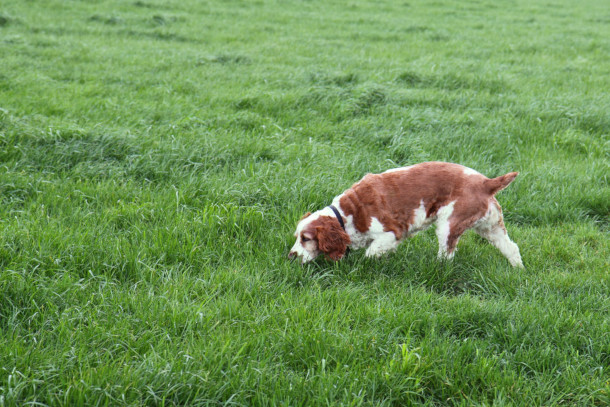
Smell is a primary sense for dogs, and they only have two color receptors in their eyes compared to three in humans (Photo: Petr Kratochvil, public domain pictures)
YONG: Yeah, I mean, so I write in that chapter that smell is a primary sense for dogs. It is their main gateway to the world around them, and I think humans forget this sometimes, and, as you say, like a lot of dog owners will yank their dogs along on a walk on the assumption that the point of the walk is exercise. And that is certainly one of the points, but I think it's also really important to let dogs be dogs. I had the good fortune of writing that segment of the book before I got my pandemic puppy. So he's a corgi, he's two years old, his name is Typo, good writer name, and when he sniffs a patch of sidewalk that another dog has peed upon, that is very similar to me checking my Instagram or my Twitter feed, you know, it is a social activity, it tells him about what other dogs that he knows about in the neighborhood have been up to, possibly their health, what they've eaten recently. And if I was to deprive him of that, I think I would be severing him from a really important part of his doghood. You know, it would be like if I went on a hike with a friend and every time I tried to look at a beautiful vista or sunset, my friend covered my eyes and pulled me along. So this is, I think, one of the themes of the book like by not thinking about the umwelten of other animals, we can do them harm, like we can misinterpret their needs, their behaviors, their actions, sometimes in detrimental ways. And conversely, by thinking about their senses, you know, we can afford to them a better quality of life, more respect, and, you know, we can feel a more profound connection to them.
CURWOOD: Indeed, so thank you for that. And there's another jewel of understanding in your book which is around the perception of ultraviolet light. Just explain how this perception of UV works and why there's a difference.
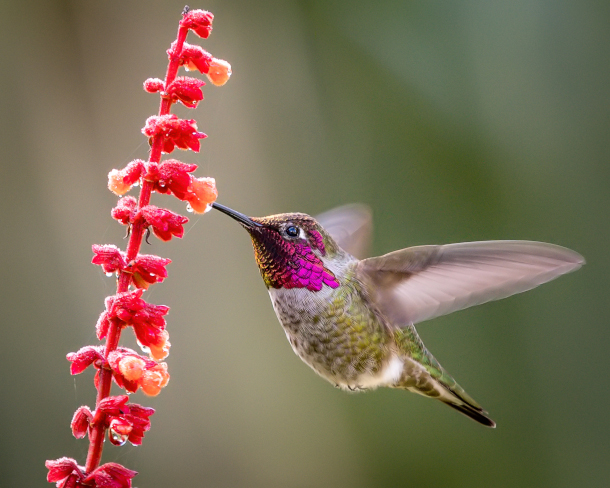
Birds have four color receptors in their eyes, giving them the ability to see ultraviolet hues common on flowers and other birds, but invisible to humans. (Photo: Becky Matsubara, National Science Foundation, CC BY 2.0)
YONG: So color vision works very differently in other species. So humans have trichromatic vision. That means we have three kinds of color-sensing cells in our eyes that combine to create the million or so colors that we can see. A dog has just two, rather than three, and so their color vision is more limited. Now there is this common myth that dogs can't see color at all that is wrong. But their rainbow is really limited to blues and yellows, they don't get the reds, they don't get the violets, they don't really get the greens in the middle. However, a lot of animals including most birds, many insects, some fish, are tetrachromatic, they have four kinds of color-sensing cells, which means that they have access to an entire dimension of colors that we can't see. That might include ultraviolet, a color at the far end of the rainbow, literally beyond violet, that's what 'ultraviolet' means, but it also includes ultraviolet in combination with the other colors that we do see, creating this huge cocktail of hues that we are completely oblivious to. And if you have this kind of vision, then a lot of the world looks very different. So a lot of birds where males and females look identical to our eyes, the sexes actually look very different to the birds themselves, because they have the ability to see all of these extra colors than we can't. Flowers can look very different. A lot of flowers have vivid ultraviolet markings on them that guide insects to sources of nectar. So, a sunflower, if I asked you what color a sunflower is, you'd probably say yellow, but to a bee, a sunflower has a vivid ultraviolet bullseye at its center. There are many, many examples of this and I think it tells us that in much of the world, actually, we are getting a very, very specific view of even things that we consider to be brightly and vividly colored, and that is not what other animals might see
CURWOOD: Yeah, our construct. And hey, somebody that you met while researching this book and who was featured in the same chapter as you have on dolphins and bats is Daniel Kish. Please take a moment to tell us his story and why it's important that more people should hear this story.
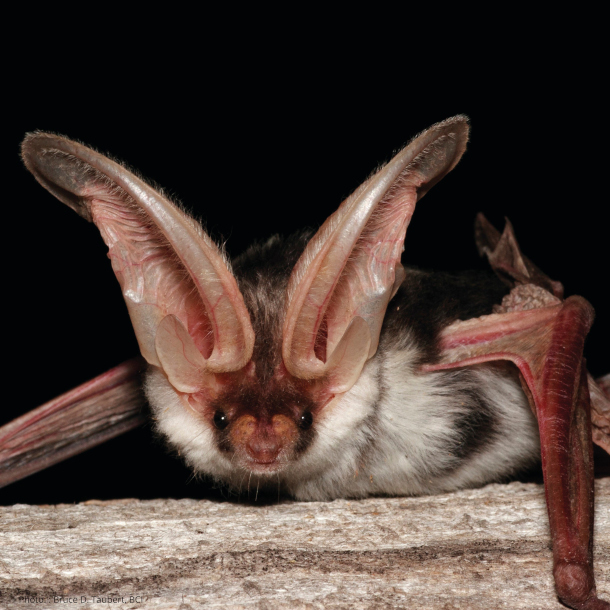
It has been known for decades that some humans can echolocate like bats can. The Spotted Bat has the largest ears of any of the 47 bat species in the US, which it uses to hunt moths at night. (Photo: Bureau of Land Management, Flickr, CC BY 2.0)
YONG: So Daniel is blind and has been blind from close to birth. And he gets around using a long cane, as many blind people do. But he also echolocates, so he does the thing that bats and dolphins do, he makes loud sharp noises, in Daniel's case with his tongue, he makes these incredibly loud, precise clicks with his tongue, and he perceives the world in the rebounding echoes. And his skill at doing this is really extraordinary, you know, I've gone for walks with Daniel in his neighborhood. And sure he's using the cane and that helps him a lot. But he also has just a very deep awareness of his surroundings, like he'll be able to duck a tree branch lying across his path, he'll be able to tell me, as we're walking along the street, where cars are, where houses are, where lawn converts to gravel converts to concrete, back to lawn. He has this incredible awareness of his surroundings because of echoes. And he's not as skilled as a bat, he likes to point out that they've had millions of years of headstart on him, but he's very good at this. He developed this ability on his own and is now teaching other people to do it. And I think that has a couple of lessons for us. Firstly, the scientific paper in 1944 that first coined the word 'echolocation' used it in the context of bats and people. So it's been well known for a long time that a lot of blind people can do this. And yet, even today, a lot of researchers who study echolocation aren't aware that human echolocation is a thing. And I think that's, in part, because of ableism, because we underestimate the abilities of people who don't have a typical sensorium. And I think it also shows that even within a species, in this case humans, the umwelt can be very, very different. You know, it's often said, when writing about the senses, that humans are a visual species, and it seems to, you know, disregard the millions of people who get by very well without any sight at all. And the other thing that I think that Daniel's story really tells us that's very important is that when thinking about the senses of another animal or another individual, there's always going to be a gap that we cannot cross, I can tell you about what scientific research says about their experience of the world, but I can't really tell you what it's like to be a dog or be a whale. Now, you might think that in the case of Daniel, it would be easy because he's another person we speak the same language he has words with which to describe his experience which an elephant or a dog does not have. And yet, I still don't really know what it's like to experience the world in the way that Daniel does. And I think it's important to recognize that this is a task that we'll never really be able to accomplish. The glory is in the attempt to do so, the effortful work of trying to extend our curiosity and our empathy into the lives of other people and other creatures. And I think that's one of the things I really hope to instill in readers of this book that rather than walk past an animal, you know, rather than trying to shoo it away from our homes, or, or any of those kinds of reactions, I would hope that it makes people stop and watch and think about the other creatures that we share this planet with.
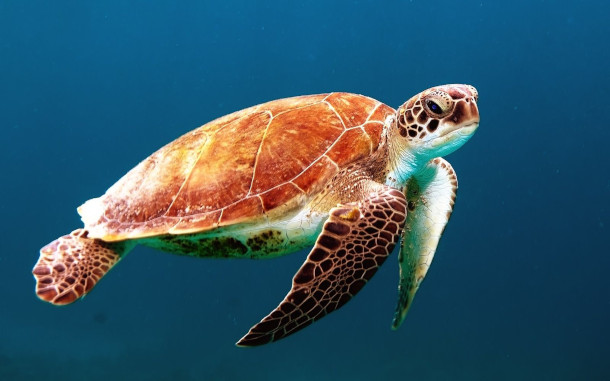
Sea turtles can sense the magnetic field of the Earth, allowing them to migrate great distances and find their way back to exactly the same beach they hatched on (Photo: Wexor Tmg, Wikimedia Commons, Public Domain)
CURWOOD: You know, I did find it interesting that some of the pictures that you have in your book, great color photos, there must be, what, 50 or something? One of them included the face of a rattlesnake. You know, and for the first time, I saw this really artfully done photograph of a rattlesnake's face, not about to strike, not with the mouth open, which is, sort of, typically what you might see, but just head on and it made me think, so I think you've accomplished something there. Now, humans, us folk, we are really disrupting this planet and the creatures living on it in so many ways. I mean, how our human activities are having such negative impacts on wildlife, you know, despite our supposedly superior sight, I'm thinking of both noise and light, for example.
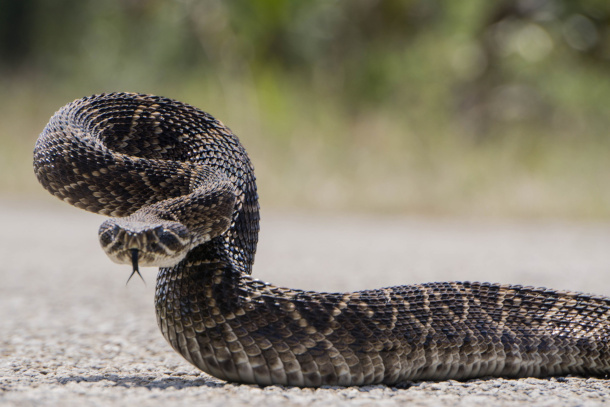
Rattlesnakes smell in stereo with their forked tongues, which they flick to create air vortices, pulling in the air from either side. They can also sense the infrared light given off by the body heat of their prey. (Photo: Jean Beaufort, Public Domain Pictures)
YONG: Yeah, so the final chapter of the book talks about this issue of sensory pollution. So that's where we have flooded the world with too much information, too much light in the dark, too much noise in the quiet. And we don't necessarily think of light and noise as pollutants in the same way that we might think of plastics or environmental toxins, but they very much are. When they exist in places where they don't belong, or at times when they don't belong, they can seriously harm the animals around us. They can waylay migrating birds from their paths, they can pull hatchling sea turtles up a beach rather than towards the ocean where they belong. They can distract pollinating insects from the flowers that they ought to be servicing. These are significant problems and I think these are important problems to grapple with, in part, because they are solvable ones. A lot of the ecological sins that we have foisted upon the planet are very hard to undo. You know, if all greenhouse gas emissions were to cease tomorrow, a lot of the future of climate change would be baked in. If we ceased all plastic pollution tomorrow, the plastics that we have already produced would continue to despoil the oceans for decades and centuries to come. But if we switched off a lot of stuff, much light and noise pollution would stop immediately. That's a very rare opportunity for an ecological win, and one that I think we should take up. You know, a lot of the ways in which we can reduce light and noise pollution, switching off lights and noise, reducing the speed of things like ships or cars, are eminently doable. They just require political will to achieve.
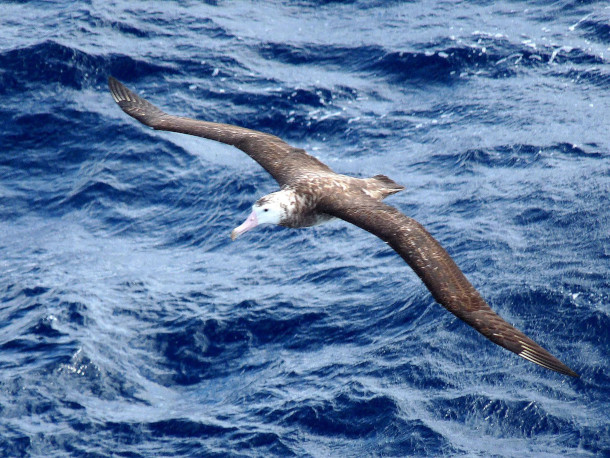
Plankton release chemicals when they are eaten by krill, which seabirds such as albatrosses can smell from miles away in order to locate krill to feed on in a seemingly featureless ocean (Photo: Michael Clarke, Wikimedia Commons, CC BY-SA 2.0)
CURWOOD: And understanding. So I think one of the big things is that this book really is fun. For anyone who wants to learn something new about something under our noses. And come on, how much fun was this for you? I mean, you were hanging out with scientists in their labs, you were clipping microphones to leaves to eavesdrop on insects, you know. Of course, there's this stuff about getting punched by a mantis shrimp. I mean, wow, how much fun did you have?
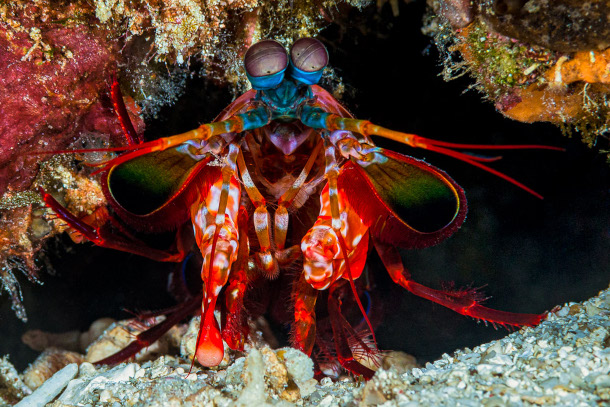
Mantis Shrimps can see the visible spectrum, UV light and polarized light with different parts of their eyes (Photo: François Libert, Flickr, CC BY-NC-SA 2.0)
YONG: I had an absolute blast. I did about half of the writing and the research before the pandemic began and then finished the second half in the middle of my COVID reporting and, you know, it was like mainlining joy and wonder at a time when I think I certainly, and, I think, all of us, could use a lot more of it. And one of the things I love the most about this topic, the ways in which animals sense and experience the world is that it is so scientifically and philosophically rich. There are truly wonders everywhere you look and sensory biologists tend to often work with, you know, weird creatures that other scientists ignore. So this book is full of common animals and familiar ones, yes, like elephants, whales, dogs, but also strange ones like mantis shrimps and star-nosed moles and naked mole rats. And it's almost like the entirety of the animal kingdom is here and all of it has, you know, rich detail and stories to tell.
BASCOMB: That’s Pulitzer Prize winning author Ed Yong talking about his book “An Immense World: How Animal Senses Reveal the Hidden Realms Around Us”. He spoke with Living on Earth’s Steve Curwood. You can find a video recording of their full conversation at the Living on Earth website, loe.org.
Links
Living on Earth wants to hear from you!
Living on Earth
62 Calef Highway, Suite 212
Lee, NH 03861
Telephone: 617-287-4121
E-mail: comments@loe.org
Newsletter [Click here]
Donate to Living on Earth!
Living on Earth is an independent media program and relies entirely on contributions from listeners and institutions supporting public service. Please donate now to preserve an independent environmental voice.
NewsletterLiving on Earth offers a weekly delivery of the show's rundown to your mailbox. Sign up for our newsletter today!
 Sailors For The Sea: Be the change you want to sea.
Sailors For The Sea: Be the change you want to sea.
 The Grantham Foundation for the Protection of the Environment: Committed to protecting and improving the health of the global environment.
The Grantham Foundation for the Protection of the Environment: Committed to protecting and improving the health of the global environment.
 Contribute to Living on Earth and receive, as our gift to you, an archival print of one of Mark Seth Lender's extraordinary wildlife photographs. Follow the link to see Mark's current collection of photographs.
Contribute to Living on Earth and receive, as our gift to you, an archival print of one of Mark Seth Lender's extraordinary wildlife photographs. Follow the link to see Mark's current collection of photographs.
 Buy a signed copy of Mark Seth Lender's book Smeagull the Seagull & support Living on Earth
Buy a signed copy of Mark Seth Lender's book Smeagull the Seagull & support Living on Earth

